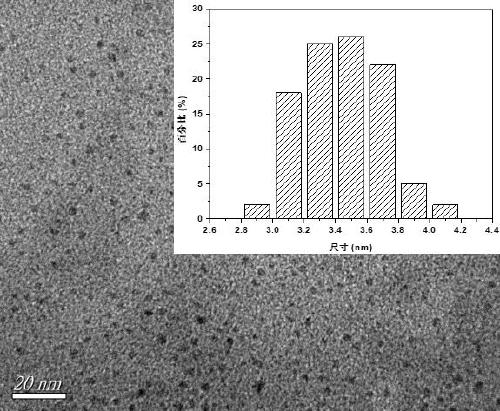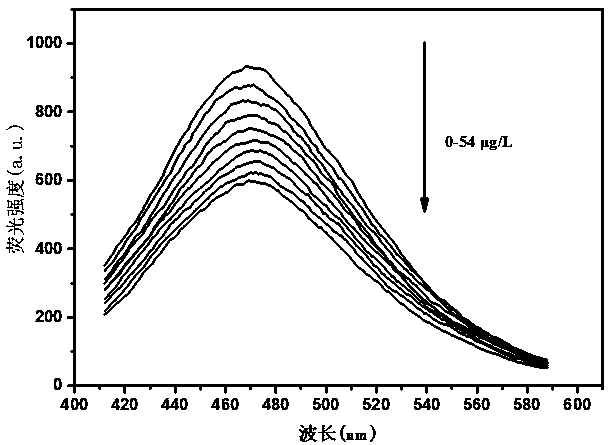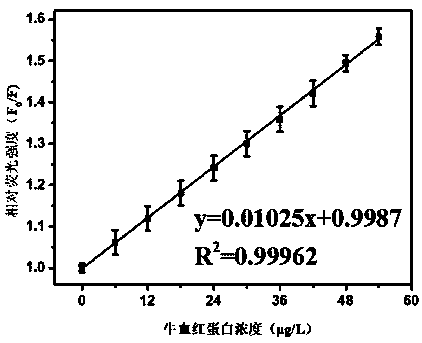Fluorescence carbon spot as well as preparation method and application thereof
A technology of fluorescent carbon dots and leaves, applied in the direction of fluorescence/phosphorescence, chemical instruments and methods, nano-carbon, etc., can solve the problems of complex preparation methods of carbon dots, difficulty in long-term use, and danger, and achieve good optical detection ability, Uniform dispersion and resource saving effect
- Summary
- Abstract
- Description
- Claims
- Application Information
AI Technical Summary
Problems solved by technology
Method used
Image
Examples
Embodiment 1
[0024] (1) Pretreatment of sweet-scented osmanthus leaves:
[0025] Pick some fresh sweet-scented osmanthus leaves, wash them several times with tap water, and then wash them with deionized water; put the washed sweet-scented osmanthus leaves in an oven at 40°C and dry them for one week; crush them with a pulverizer, and sieve them through a 150-mesh sieve , to obtain the osmanthus leaf powder, set aside.
[0026] (2) Preparation of fluorescent carbon dot dispersion:
[0027] Weigh 1 g of osmanthus leaf powder in a round bottom flask, add 40 mL of deionized water, add 0.5 mL of polyethyleneimine solution with magnetic stirring, and magnetically stir for 24 h; centrifuge to collect the supernatant; in order to remove insoluble impurities and unreacted The supernatant collected by centrifugation was filtered with a filter membrane with a pore size of 0.22 μm, and then dialyzed with a dialysis bag with a molecular weight cut-off of 3500 to obtain a fluorescent carbon dot dispers...
Embodiment 2
[0029] (1) Pretreatment of sweet-scented osmanthus leaves:
[0030] Pick some fresh sweet-scented osmanthus leaves, wash them several times with tap water, and then wash them with deionized water; place the washed sweet-scented osmanthus leaves in an oven at 50°C, and dry them for one week; crush them with a pulverizer, and sieve them through a 150-mesh sieve , to obtain the osmanthus leaf powder, set aside.
[0031] (2) Preparation of fluorescent carbon dot dispersion:
[0032] Weigh 1 g of sweet-scented osmanthus leaf powder in a round bottom flask, add 80 mL of deionized water, add 2 mL of polyethyleneimine solution with magnetic stirring, and magnetically stir for 36 h; centrifuge to collect the supernatant; in order to remove insoluble impurities and unreacted The supernatant collected by centrifugation was filtered with a filter membrane with a pore size of 0.22 μm, and then dialyzed with a dialysis bag with a molecular weight cut-off of 3500 to obtain a fluorescent car...
Embodiment 3
[0034] (1) Pretreatment of sweet-scented osmanthus leaves:
[0035] Pick some fresh sweet-scented osmanthus leaves, wash them several times with tap water, and then wash them with deionized water; place the washed sweet-scented osmanthus leaves in an oven at 60°C, and dry them for one week; crush them with a pulverizer, and sieve them through a 150-mesh sieve , to obtain the osmanthus leaf powder, set aside.
[0036] (2) Preparation of fluorescent carbon dot dispersion:
[0037] Weigh 1 g of osmanthus leaf powder in a round bottom flask, add 60 mL of deionized water, add 1 mL of polyethyleneimine solution with magnetic stirring, and magnetically stir for 48 h; centrifuge to collect the supernatant; in order to remove insoluble impurities and unreacted The supernatant collected by centrifugation was filtered with a filter membrane with a pore size of 0.22 μm, and then dialyzed with a dialysis bag with a molecular weight cut-off of 3500 to obtain a fluorescent carbon dot disper...
PUM
| Property | Measurement | Unit |
|---|---|---|
| particle diameter | aaaaa | aaaaa |
| size | aaaaa | aaaaa |
Abstract
Description
Claims
Application Information
 Login to View More
Login to View More - R&D
- Intellectual Property
- Life Sciences
- Materials
- Tech Scout
- Unparalleled Data Quality
- Higher Quality Content
- 60% Fewer Hallucinations
Browse by: Latest US Patents, China's latest patents, Technical Efficacy Thesaurus, Application Domain, Technology Topic, Popular Technical Reports.
© 2025 PatSnap. All rights reserved.Legal|Privacy policy|Modern Slavery Act Transparency Statement|Sitemap|About US| Contact US: help@patsnap.com



